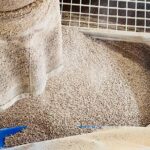By T.J. Gaydos
Management practices and feed additive selection are often discussed when working in antibiotic-free (ABF) poultry production. Nutrition is another critical component of any agricultural animal system. Working with a qualified nutritionist will help ensure that the diet is correctly formulated with high-quality ingredients.

5 nutrition tips for antibiotic-free poultry production
1. Consider feed form and delivery
Feed form and delivery are nearly as important as the nutrient content of the formulation. If feed form or handling is improper and feed separates, is improperly mixed, or oxidized, the birds will not appreciate the effort that went to develop a balanced diet. A durable pellet or crumble is important to allow all birds to have equal access to a nutritionally complete diet with every bite.
Additionally, if the finished feed or individual ingredients are not stored properly, they may not have the same value that is attributed to them in the formulation process. Other than correct nutrient formulation, three parts of the diet that should be considered are feed additives, mycotoxin contamination, and lipid oxidation.
2. Prevent oxidative stress
The impact of oxidative stress on the intestinal mucosa, immune system, and performance is well-documented across species. Oxidized fat sources reduce the available energy, but equally significant to bird health is the reduction in vitamin availability, resulting in increased oxidative stress for the animal. Protecting the sources of fat and the finished feed is important to spare fat-soluble vitamins, specifically vitamin E.
Oxidized fat can also irritate the intestinal mucosa leading to decreased absorption of nutrients. The process of breaking down macromolecules during digestion and converting them to forms useful for further metabolism is a significant contributor to oxidative stress. The immune system is also a great contributor to oxidative stress. Immune cells use reactive oxygen species to kill pathogens that are phagocytosed.
A large portion of the immune system is located in the GI tract in order to protect the animal from pathogens crossing from the gut into the animal. In addition to being a contributor to oxidative stress, the immune system can be negatively impacted by oxidized feed (Liang et al., 2015). The combination of metabolic and immune activity in the intestines puts it at a high risk of damage from oxidative stress. It is vital to protect fat sources with synthetic or natural antioxidants; reducing the incoming stress from oxidized fat should be a priority to improve poultry health.

3. Mitigate mycotoxin risks
Another risk to bird health and mucosal integrity is mycotoxins. Diets containing mycotoxins may damage the mucosa of the GI tract directly or may damage other organs leading to significant health challenges and decreases in performance. Some mycotoxins or compounds created by fungi can disrupt the intestinal microflora by acting on bacterial cells, as many fungal metabolites are antimicrobial.
The best approach to managing mycotoxins is eliminating them from the system by purchasing high-quality grain and storing it appropriately. It is impossible to completely eliminate all risks of receiving ingredients contaminated with mycotoxins. An internal program should be developed to test the incoming ingredients and finished feed regularly for mycotoxins.
Knowing the challenging ingredient sources may help reduce the risk to highly susceptible birds like Breeders or chicks through dilution in formulation or the addition of toxin binders and/or enzymes. Several toxins may be found in a feed stuff and many of the mycotoxins are synergistic in their deleterious effects (Murugesan et al., 2015). Different binders have varying affinity for different mycotoxins; closely examining the product literature can help to choose the correct product to mitigate risk.
4. Choose optimal additives
Choosing the correct feed additive program for intestinal health, food safety, and growth performance depends on the specific challenges in the complex. When selecting a feed additive that is not FDA approved, it is important to base the decision as much as possible on scientific evidence through peer-reviewed research.
In addition to published data, internal testing within the production system is also helpful to ensure the product matches the local challenge. In a market saturated with “natural” products, it is essential to find a supplier that is trustworthy and is engaged in the success of the complex and health of the birds, not only in selling products. A partnership will be much more successful in the long term than only a buy/sell arrangement.
5. Manage expectations
When considering removing antibiotics from a program, the temptation is to expect natural products to completely replace the efficacy of antibiotics. This is an unreasonable expectation. The success of a transition to ABF production relies on modifying management practices as well. The vast majority of program success is related to attention to the details of husbandry, biosecurity, and sanitation. The remaining opportunity to improve health rests on the additive program.
References
Liang, Fangfang, Shouqun Jiang, Yi Mo, Guilian Zhou, and Lin Yang. “Consumption of Oxidized Soybean Oil Increased Intestinal Oxidative Stress and Affected Intestinal Immune Variables in Yellow-Feathered Broilers.” Asian-Australasian Journal of Animal Sciences 28, no. 8 (2015): 1194–1201. https://doi.org/10.5713/ajas.14.0924.
Murugesan, G.R., D.R. Ledoux, K. Naehrer, F. Berthiller, T.J. Applegate, B. Grenier, T.D. Phillips, and G. Schatzmayr. “Prevalence and Effects of Mycotoxins on Poultry Health and Performance, and Recent Development in Mycotoxin Counteracting Strategies.” Poultry Science 94, no. 6 (2015): 1298–1315. https://doi.org/10.3382/ps/pev075.
















